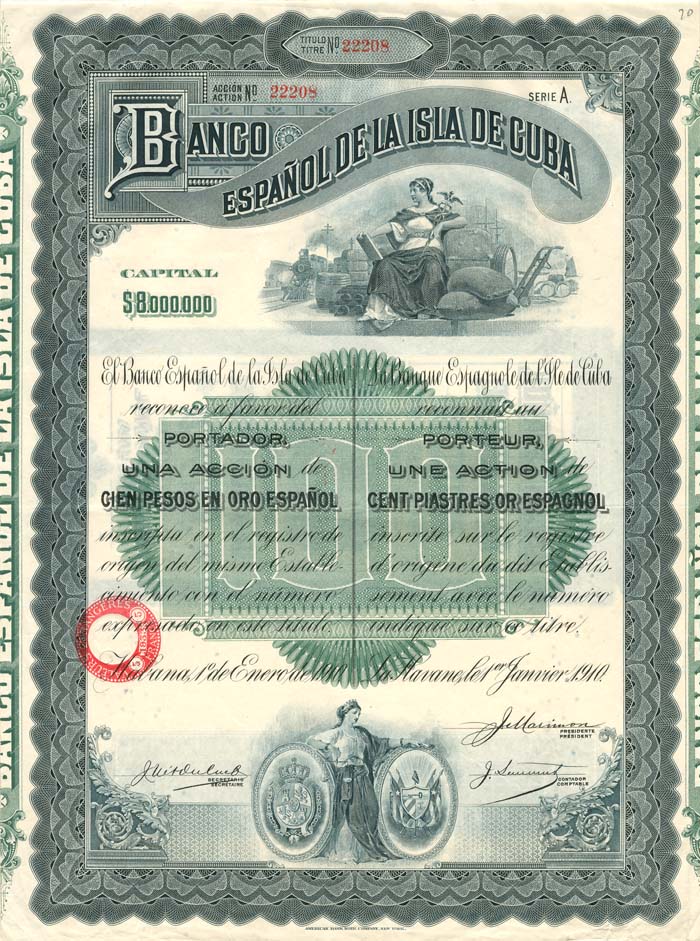Banco Espanol De La Isla De Cuba - Stock Certificate
Inv# FS1445 Stock
Stock for 100 Gold Piastres Espagnol.
The piastre (in Commonwealth English) or piaster (in Northern American English) is any of a number of units of currency. The term originates from the Italian for "thin metal plate". The name was applied to Spanish and Hispanic American pieces of eight, or pesos, by Venetian traders in the Levant in the 16th century.
These pesos, minted continually for centuries, were readily accepted by traders in many parts of the world. After the countries of Latin America had gained independence, pesos of Mexico began flowing in through the trade routes, and became prolific in the Far East, taking the place of the Spanish pieces of eight which had been introduced by the Spanish at Manila, and by the Portuguese at Malacca. When the French colonised Indochina, they began issuing the new French Indochinese piastre (piastre de commerce), which was equal in value to the familiar Spanish and Mexican pesos.
In the Ottoman Empire, successive currency reforms had reduced the value of the Ottoman piastre by the late 19th century so as to be worth about two pence (2d) sterling. Hence the name piastre referred to two distinct kinds of coins in two distinct parts of the world, both of which had descended from the Spanish pieces of eight.
Because of the debased values of the piastres in the Middle East, these piastres became subsidiary units for the Turkish, Cypriot, and Egyptian pounds. Meanwhile, in Indochina, the piastre continued into the 1950s and was subsequently renamed the riel, the kip, and the dong in Cambodia, Laos and Vietnam respectively.
Under the Spanish Administration, the Banco Español de la Habana introduced Cuba's first issue of banknotes in 1857 in denominations of 50, 100, 300, 500 and 1,000 dollars. The 25 peso denomination was introduced in 1867, and the 5 and 10 peso denominations in 1869. During the Ten Years' War, notes were issued dated 1869 in the name of the Republic of Cuba in denominations of 50 centavos, 1, 5, 10, 50, 500 and 1000 pesos.
In 1872, 5, 10, 25 and 50 centavo, and 1 and 3 peso notes were introduced by the Banco Español de la Habana. In 1891, the Treasury issued notes for 5, 10, 20, 50, 100 and 200 pesos. In 1896, the name of the bank was changed to the Banco Español de la Isla de Cuba, and it issued notes in denominations of 5 and 50 centavos and 1, 5 10, 50, 100, 500 and 1000 pesos, followed by 10 and 20 centavos in 1897.
In 1905, the National Bank of Cuba (Banco Nacional de Cuba) issued notes for 1, 2, 5 and 50 pesos. However, the 1905 banknotes were not issued (source: Pick's catalog) In 1934, the Government introduced silver certificates (certificados de plata) in denominations of 1, 5, 10, 20 and 50 pesos, followed by 100 pesos in 1936 and 500 and 1000 pesos in 1944.
A stock certificate is issued by businesses, usually companies. A stock is part of the permanent finance of a business. Normally, they are never repaid, and the investor can recover his/her money only by selling to another investor. Most stocks, or also called shares, earn dividends, at the business's discretion, depending on how well it has traded. A stockholder or shareholder is a part-owner of the business that issued the stock certificates.










Ebay ID: labarre_galleries